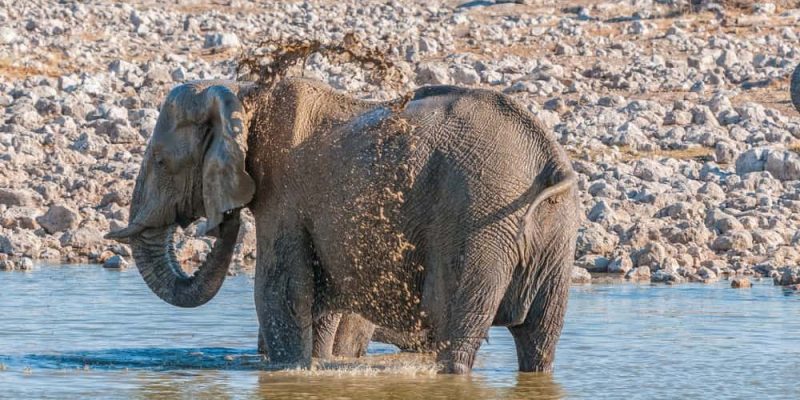We explain everything about the elephant, its reproduction, food, habitat and other characteristics. Also, what types of elephants exist.

What are elephants?
The elephants are a family of large quadrupedal mammals, famous for their large ears and prehensile trunk as well as their long white ivory tusks, in addition to being the largest land animals that exist in the world today.
Currently There are three different species of elephants, each with its respective subspecies and there are paleontological remains of extinct species, such as mammoths.
The immediate ancestors of these animals emerged around 50 or 60 million years ago, and were particularly successful in colonizing all continents and habitats, with the exception of Antarctica and Australia. Eventually, an ancestor known as palaeomastodonwho lived 40 to 25 million years ago, gave rise to the different species of elephants that we know today.
Human beings have known elephants since ancient times and in certain geographies they were domesticated and incorporated into productive tasks, or used as war mounts. For example, the historical episode of the war between Ancient Rome and Carthage (known as the Punic Wars) is famous, in which Hannibal, the Phoenician general, crossed the Alps to invade Rome with an army mounted on elephants.
See also: Animals of the African savanna
Characteristics of elephants

In general, elephants are characterized by the following:
- They are voluminous animals, whose bodies can measure about 4 meters high and weigh several tons (on average, about 7500 kg). Its brain, the largest of all land animals, weighs 5 kg alone, and gives the elephant an intelligence comparable to that of a cetacean or some primates.
- Its trunk, the best-known feature of the species, has thousands of muscles (40,000 or 100,000 according to different sources) and is a sensitive extension of the nose, capable of perceiving an immense range of distant odors (elephants have the best sense of smell of all species), collecting food from the ground, inhaling and pouring water into your mouth or on your body to cool off, or emit sounds of various ranges, including infrasonic ones.
- At the same time, have enormous pinnae, which allow them a keen sense of hearing. On the other hand, they have poor vision, with their eyes on the sides of their heads, which makes them particularly sensitive to sudden and sudden movements, to which they usually respond aggressively.
- The males of the species have two gigantic ivory tusks extension of their incisor teeth, which protrude from their upper jaw and that these animals use to make their way through the thickets, dig in the ground, mark their territory or attack and defend themselves, if necessary. Composed of ivory, they have been highly valued throughout history and are one reason why they have been hunted so extensively.
- His skin is thick and wrinkled grayish or brownish in color, and have thin, sparse fur. To avoid dehydration, they usually spend a lot of time in water, and cover themselves with a film of mud that protects them from sunlight.
- Traditionally they are attributed with good memory which seems to be true, and they are known to have rich social interaction, with abundant gestures of empathy, compassion, play, primitive use of tools and self-recognition.
- It is also said that they are afraid of mice (which is totally false), and that they make their own cemeteries. The latter may be a misinterpretation of the fact that dying elephants instinctively seek water, which is why they tend to leave their bodies in similar regions. However, yes Elephants have been seen recognizing the remains of their species among those of others and play with them as if paying them some kind of tribute.
Where do elephants live?
Current species of elephants live in warm areas of forests, grasslands and savannahs, in Africa and certain regions of Asia such as India, Sri Lanka, Malaysia, Indonesia, Thailand and Vietnam. In fact, species are usually distinguished according to their usual home of residence: African elephants and Asian elephants, since they have different physical traits.
The elephants live in herds, led by the oldest females that is, the matriarchs, and the packs are made up of several family groups, in which there are usually between two and eight individuals.
What do elephants eat?
The elephants are herbivores and their diet consists mainly of grasses, seeds, bark and other plant fibers.
How do elephants reproduce?

Like other mammals, elephants reproduce sexually and viviparously, but have long gestation periods (in some species they can reach 22 months, and once every four or five years) at the end of which a single offspring is born, whose initial weight ranges from 118 kg.
Elephants are very jealous of their young, and in a herd there can be between 20 and 40 matriarchs with their respective young. The males, on the other hand, leave the herd early, between 10 and 14 years of age.
How long do elephants live?
The average life expectancy of the elephant ranges between 60 and 80 years of age.
Types of elephants
As we said before, elephants are classified into three species, grouped into two different genera, which we can summarize as follows:
- African elephants (gender Loxodonta): two different species, which are the African bush elephant (African Loxodonta), and the African jungle elephant (Loxodonta cyclotis).
- Asian elephants (gender Elephas): a single species that is in turn classified into three current subspecies: the Sri Lankan elephant (Elephas maximus maximus), the Indian elephant (Elephas maximus indicus) and the Sumatran elephant (Elephas maximus sumatranus).
It is important to note that in some zoological classifications, a distinction is made between the Indian elephant (Elephas maximus indicus) and two other subspecies: the Bornean elephant (Elephas maximus borneensis) and the Malaysian elephant (Elephas maximus hirsutus). But there is still debate in the scientific community about it.
Continue with: Giraffe
References
- “Elephantidae” on Wikipedia.
- “Elephants” in National Geographic.
- “9 surprising facts about elephants” in World Wildlife Fund (WWF).
- “The Elephant” (video) in Happy Learning Spanish.
- “Elephant (mammal)” in The Encyclopaedia Britannica.





